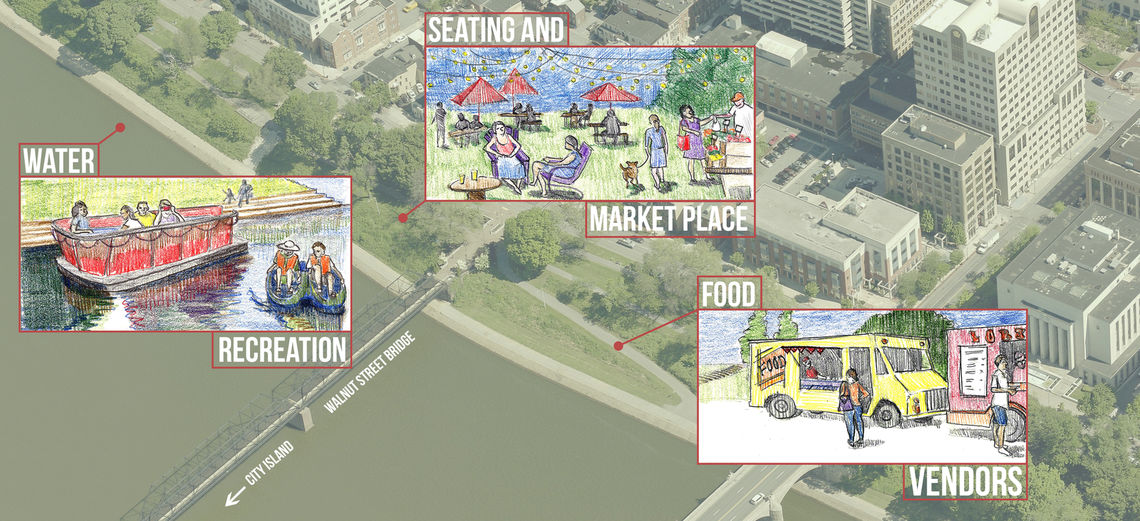A reimagining of the Susquehanna River Waterfront in Harrisburg, Pennsylvania
By Owen Hitchcock
The Susquehanna River winds its way through the capital city of Harrisburg, Pennsylvania, providing the perfect setting for Riverfront Park. This park parallels the river through the downtown area and offers residents and visitors a great setting to walk, jog, bike, picnic, or relax by enjoying the Susquehanna views. The park sits at the street level, and the river itself is farther down an embankment. While the elevation difference provides picturesque views of the river, park guests cannot experience the novelty of being right at the water’s edge, even though the opportunity could be there for them.
Riverfronts unobstructed by highways or industrial facilities are rare. Both I-95 along the Delaware River in Philadelphia and I-376 along the Monongahela River in Pittsburgh are examples of barriers between rivers and downtown areas. The Susquehanna River’s existing concrete path runs directly along the water’s edge with steps leading down into the river, but it is underutilized today despite its prime location. A reimagining of this path – which could be called The Waterfront at Susquehanna (The Waterfront) – into a shopping and dining destination could invigorate the waterfront. The idea of this destination is bold, the user experience is unlike other U.S. cities, and the development is feasible.
The vision of this project is to create a seasonal public marketplace and pop-up events for local food, drinks, art, and crafts. Vendors could sell merchandise from mobile stalls, including tents, trailers, small trucks, and even boats. The Waterfront would ideally be developed along the river surrounding the Walnut Street Bridge. This location is close to the downtown offices for Harrisburg residents and employees, making it a preferred choice for lunch or after-work happy hours. The bridge connects Harrisburg to City Island, a popular entertainment destination that is home to the Harrisburg Senators, the local minor-league baseball team, as well other attractions. Setting the Waterfront directly at the end of the bridge also makes it an accessible and enticing place for tourists. An existing ramp would provide truck and trailer access to the site on one end of the bridge, and an existing staircase provides pedestrians access to the site on the other. Vendors could be located between these access points to avoid dead ends. The convenient location would draw visitors in, while the unique experience would keep them there.
own hitchcock plan

The Waterfront would create a unique one of a kind experience that combines the ambiance of a crafts market with the lively atmosphere of a riverside destination. Street musicians could provide entertainment and atmosphere. At night, hundreds of lights would illuminate the marketplace to create a setting reminiscent of Spruce Street Harbor Park in Philadelphia. Visitors would relax with their food and drinks on benches, the steps, or at vendor-provided seating areas. These seating areas could include boats—one of the proposed area’s main attractions. To fully take advantage of the waterfront, restaurants and bars may choose to host on-boat dining and drinks similar to the barge dining done at the Riverwalk in San Antonio, Texas. Whether it’s a romantic boat emphasizing fine dining, a floating bar serving craft beers, or anything in between, the novelty of being on a boat creates a memorable experience. Boats are just one of the stalls used; food truck and trailer operators can park by the existing ramp where there is a flat grassy area for large vehicles. Smaller stalls, such as food stands or canopy tents for arts and crafts, could be set up on the other side of the bridge where space is more limited.
The Waterfront would create a unique, one-of-a-kind experience that combines the ambiance of a crafts market with the lively atmosphere of a riverside destination.
The steps to create this destination are achievable, largely due to the existing infrastructure. There are three major components to the process: modifying existing infrastructure, finding tenants interested in participating, and marketing the Waterfront to the public. Existing infrastructure would need to be assessed to accommodate increased activity. To increase the space available for stalls and pedestrians, excavating the existing embankment and constructing a retaining wall should be investigated. Fortunately, the existing concrete path is fairly wide, so required excavation could be minimal. Constructing a second ramp by the staircase to increase vendor and pedestrian ease of access is another modification that should be explored. Infrastructure design should also consider other needs, such as additional electrical infrastructure to handle the increased demand by vendors and lighting, and plumbing infrastructure for cooking and restroom facilities, as well as ADA accessibility. Because many visitors will come at night, enhanced street-level lighting should be explored to improve guest safety and comfort. Drainage considerations will include curb and gutter, constructed at the bottom of the embankment to remove stormwater. No additional parking is anticipated, as there is street and garage parking available near the Walnut Street Bridge and on City Island. However, a parking study could be conducted to confirm.
Marketing the Waterfront to potential tenants can draw upon groups such as the Pennsylvania Restaurant and Lodging Association, who can notify its members about the opportunity to expand businesses. The list of Artsfest vendors can be contacted to notify potential artists and crafts makers.
Marketing the Waterfront to the public can utilize social media promotion, as well as press releases and conferences announcing the planning, groundbreaking, and ribbon cutting of the project. Local newspapers and news stations, in particular, would likely be eager to cover this new attraction. Additional publicity could include coordinating the grand opening to coincide with other popular events in the area, such as the Annual Artsfest during Memorial Day, or the Fourth of July celebrations. By completing these three components, the Waterfront can go from concept to reality.
The Waterfront repurposes an underutilized and valuable location into a unique outdoor destination that provides entertainment for citizens and a new source of revenue for the city. The Susquehanna River already enables the Riverfront Park, which provides a relaxing green setting as well as a path for walkers and joggers. The Waterfront provides a third use of the river: a riverside place to socialize and spend time with friends and family. This project enhances Harrisburg’s livability for its residents, while providing another destination for Harrisburg visitors.
owen hitchcock sketch

Owen Hitchcock
Originally from Raleigh, North Carolina, Owen is a second-year graduate student pursuing his Master of Science in civil engineering at the Pennsylvania State University. In addition to being published in this magazine, he is also being awarded a scholarship for winning the inaugural Excellence Student Article Competition.